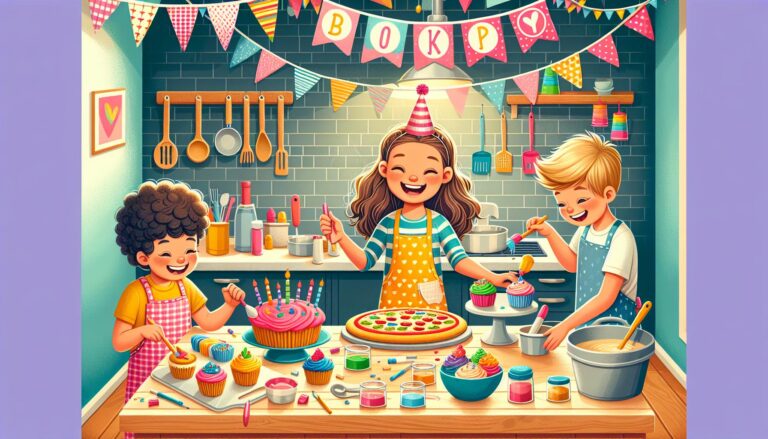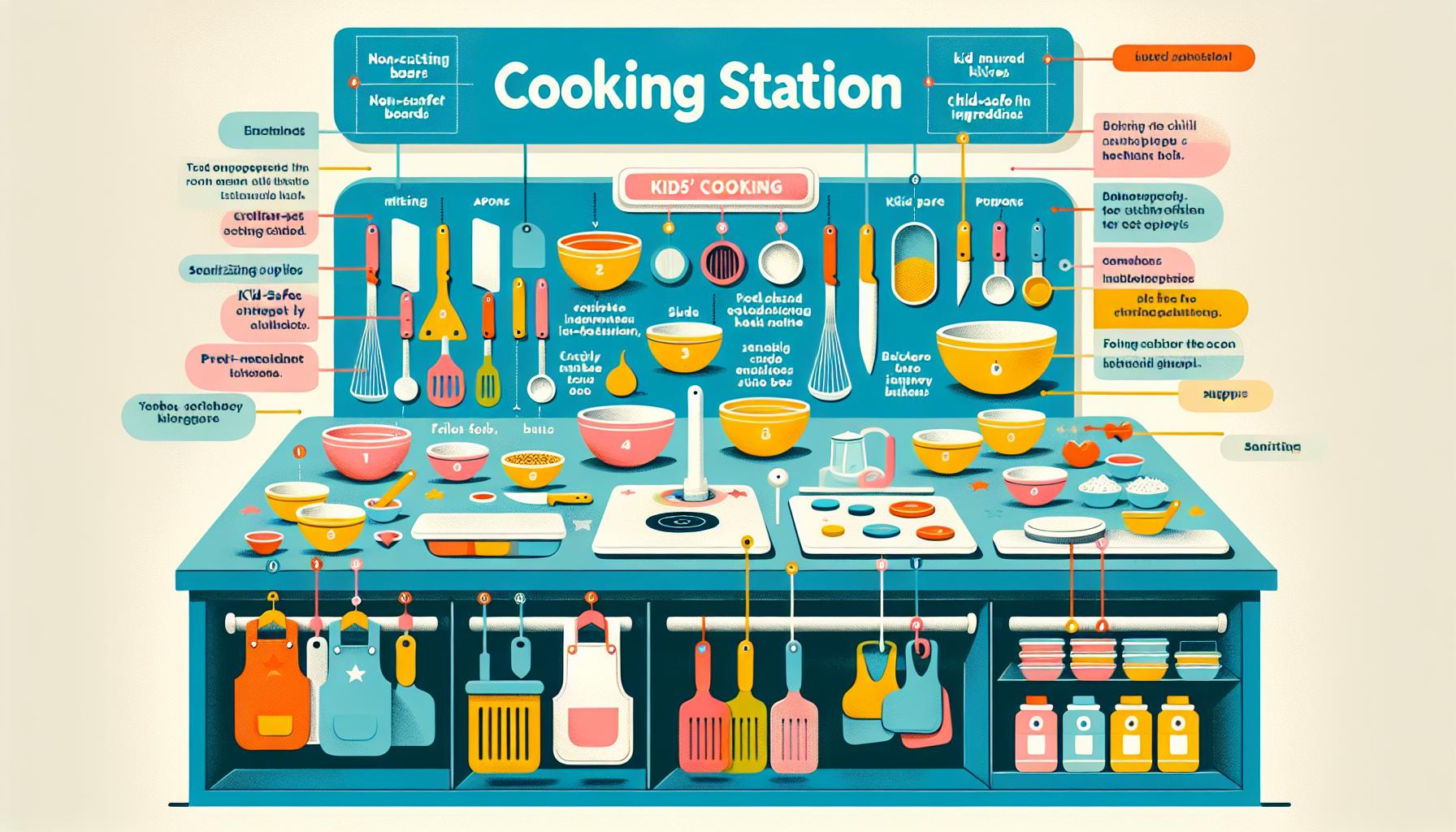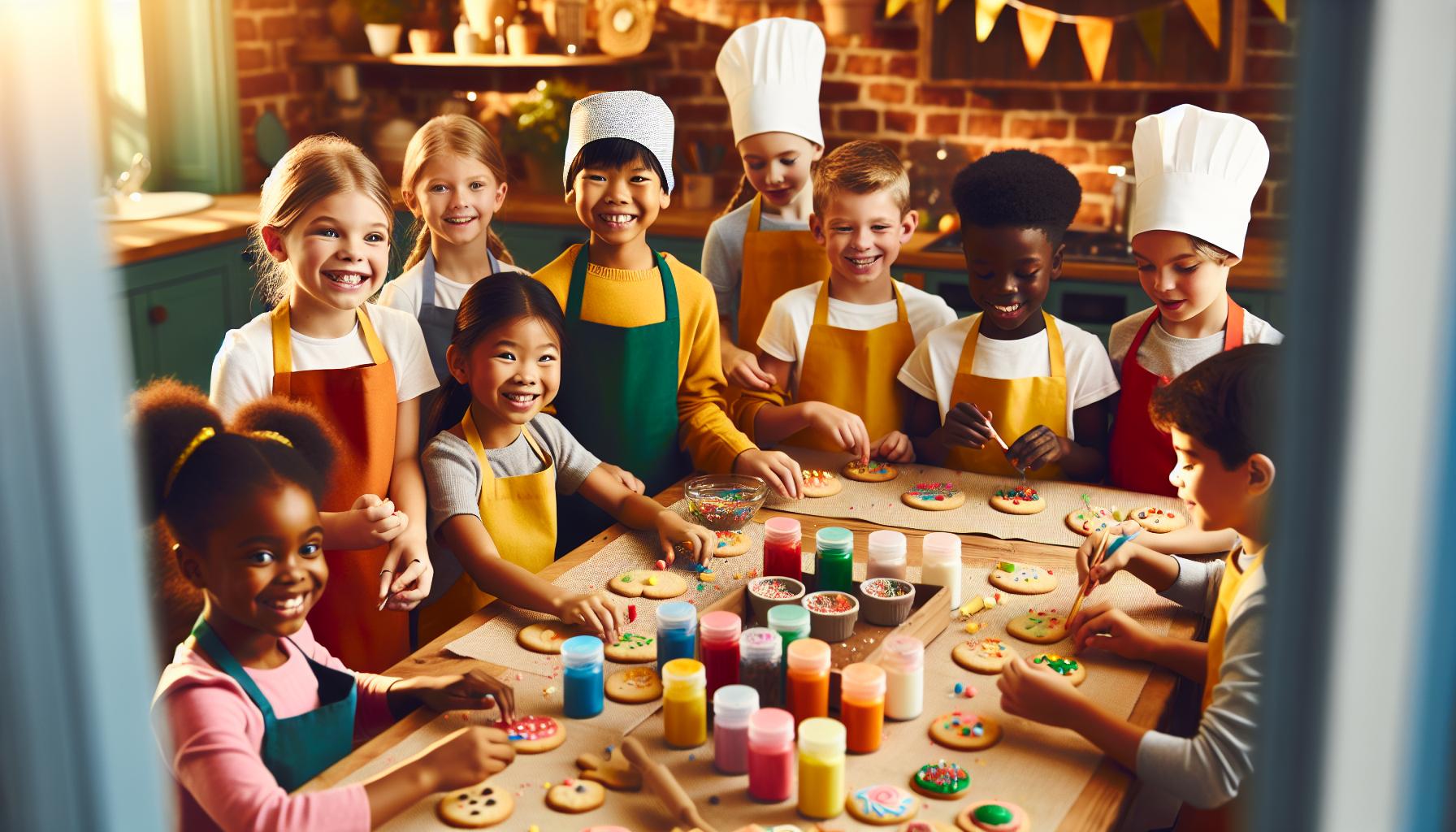
Looking for a fun way to celebrate your child’s next birthday? We’ve found that cooking parties bring kids together for an unforgettable experience filled with creativity and delicious treats. These interactive celebrations let children explore their culinary curiosity while making memories with friends.
Whether you’re planning a pizza-making extravaganza or a cupcake decorating session we’ll help you create the perfect cooking party. What could be more exciting than watching young chefs don their aprons and work together to create something tasty? From age-appropriate recipes to food safety tips and entertaining activities we’ve got everything you need to host an amazing cooking-themed celebration that’ll have everyone asking for seconds.
Key Takeaways
- Host a successful kids’ cooking party by choosing age-appropriate recipes and maintaining a 1:4 adult-to-child supervision ratio for optimal safety
- Create dedicated cooking stations with clear zones for prep, cooking, and cleaning, ensuring each child has enough workspace and easy access to pre-measured ingredients
- Select engaging themes like pizza making, cookie decorating, or mini chef challenges to keep young participants excited and involved throughout the party
- Incorporate kitchen science experiments and food-related games between cooking activities to maintain entertainment while ingredients or dishes are being prepared
- Provide themed party favors like personalized recipe cards or take-home cooking kits to extend the culinary experience beyond the celebration
Planning Your Kids’ Cooking Party
Organizing a kids’ cooking party takes strategic preparation to create an engaging culinary experience. Here’s how to set up a safe kitchen environment while keeping young chefs entertained.
Age-Appropriate Menu Ideas
The perfect menu matches children’s cooking abilities with their age group. Here’s what works best:
Ages 3-5:
- No-bake treats like chocolate-dipped fruit
- Sandwich assembly with pre-cut ingredients
- Decorated sugar cookies with premade frosting
- Fruit kebabs with soft fruits
Ages 6-8:
- Pizza with pre-made dough
- Simple smoothies with measured ingredients
- Rice krispy treats
- Rainbow fruit parfaits
Ages 9-12:
- Homemade pasta with safe equipment
- Cupcake baking & decorating
- Taco bar assembly
- Simple sushi rolls with cooked ingredients
Safety Guidelines and Equipment
Kitchen safety forms the foundation of a successful cooking party. Here are essential protocols:
Equipment Setup:
- Child-safe knives with rounded tips
- Step stools for proper counter height
- Non-slip mixing bowls
- Heat-resistant oven mitts in kid sizes
Safety Rules:
- 1 adult supervisor per 4 children
- Hand washing stations with paper towels
- Clean workspace markers for each child
- First aid kit in an accessible location
- Pre-measured ingredients in labeled containers
- Separate tools for raw & cooked foods
- Temperature-safe food storage containers
- Color-coded cutting boards for different ingredients
| Age Group | Supervisor Ratio | Equipment Level | Max Party Size |
|---|---|---|---|
| 3-5 years | 1:2 | Basic tools only | 6 children |
| 6-8 years | 1:3 | Limited heat tools | 8 children |
| 9-12 years | 1:4 | Supervised full range | 12 children |
Setting Up The Perfect Cooking Station

Creating dedicated cooking stations transforms any space into an efficient mini-kitchen for young chefs. A well-organized setup keeps ingredients accessible while maintaining safety standards for kids.
Workstation Organization
Each cooking station needs 3 distinct zones: prep area, cooking space and cleaning section. Place cutting boards at least 24 inches apart to give kids enough room to work comfortably. Set up ingredient stations with pre-measured items in small bowls for easy access. Position trash bins within arm’s reach to keep workstations tidy.
Key organization tips:
- Label each station with the child’s name using colorful tags
- Create supply zones with frequently used items in the center
- Set up sanitizing stations with paper towels and cleaning supplies
- Position step stools near counters for shorter children
- Place recipe cards in plastic sleeves at each station
Essential Kitchen Tools
Stock each station with age-appropriate tools sized for small hands:
Basic tools per station:
- 1 non-slip cutting board
- 2 child-safe knives
- 3 mixing bowls (small, medium, large)
- Measuring cups and spoons
- 2 rubber spatulas
- 1 rolling pin
- Disposable gloves
- Apron
- Hand mixer (1 per 4 kids)
- Blender (1 per 6 kids)
- Microwave (1 per 8 kids)
- Refrigerator access
- Oven access (adult-supervised only)
| Age Group | Recommended Tools | Supervision Ratio |
|---|---|---|
| 3-5 years | Plastic tools only | 1 adult : 2 kids |
| 6-8 years | Basic metal tools | 1 adult : 3 kids |
| 9-12 years | Standard equipment | 1 adult : 4 kids |
Fun Cooking Party Theme Ideas

Transform a standard birthday celebration into an interactive culinary adventure with these engaging cooking party themes. Each theme creates opportunities for hands-on learning mixed with creative expression.
Pizza Making Party
Set up individual pizza stations with pre-portioned dough balls toppings in separate containers. Create a toppings bar featuring 6-8 ingredients like shredded cheese mozzarella pepperoni sliced vegetables fresh herbs. Kids learn measuring portioning skills while customizing their personal pizzas. Include activities like dough tossing contests pizza-themed games between baking rounds.
Cookie Decorating Extravaganza
Prepare sugar cookies in advance then let kids express their creativity with frosting decorations. Set up decorating stations with 4-5 frosting colors sprinkles edible glitter candies piping bags plastic knives. Organize a friendly competition with categories like “Most Colorful” “Best Character Design” “Most Creative Pattern.” Add entertainment through cookie-themed music games while batches rotate through decorating stations.
Mini Chef’s Baking Challenge
Structure the party like a kid-friendly baking competition with 3-4 themed rounds. Divide kids into small teams giving each group pre-measured ingredients clear recipe cards simple baking tools. Create categories for judging:
- Best Presentation
- Most Creative Flavor Combination
- Team Spirit
- Following Instructions
Add excitement by setting timers for each round using a scoring system incorporating basic kitchen science lessons. Provide each participant with a special certificate highlighting their unique contribution to their team’s creations.
| Age Group | Recommended Duration | Number of Activities |
|---|---|---|
| 5-7 years | 90 minutes | 2-3 activities |
| 8-10 years | 120 minutes | 3-4 activities |
| 11-13 years | 150 minutes | 4-5 activities |
Party Activities Beyond Cooking
Cooking parties benefit from additional entertainment options that keep kids engaged between kitchen activities. Here’s how to mix education and fun with complementary activities.
Kitchen Science Experiments
Kitchen science experiments transform ordinary ingredients into exciting learning opportunities. Mix baking soda with vinegar to create colorful volcano eruptions in mason jars. Create rainbow density towers using liquids like honey honey, dish soap, water and oil. Turn milk into plastic using vinegar to demonstrate chemical reactions. These experiments take 10-15 minutes each and work best with groups of 4-6 kids.
Food-Related Games
Food-themed games maintain the culinary spirit while giving kids active breaks from cooking. Play “Food Group Relay” where teams sort plastic foods into proper categories. Set up “Pin the Topping on the Pizza” with paper ingredients and blindfolds. Create “Taste Test Challenge” stations with different flavored jellybeans or fruit juices for kids to identify. Schedule 2-3 games lasting 15 minutes each between cooking activities.
| Age Group | Science Experiments | Games | Total Activity Time |
|---|---|---|---|
| 3-5 years | 1-2 simple demos | 2-3 guided games | 45 minutes |
| 6-8 years | 2-3 interactive experiments | 2-3 team games | 60 minutes |
| 9-12 years | 3-4 hands-on experiments | 2-3 competitive games | 75 minutes |
Party Favors and Take-Home Treats
Party favors at a kids’ cooking party extend the fun beyond the celebration. These thoughtful takeaways let young chefs continue their culinary adventures at home.
DIY Recipe Cards
Create personalized recipe cards featuring the dishes made during the party. Print colorful 4×6 cards with step-by-step instructions illustrated by fun food drawings. Include these elements on each card:
- Recipe name with a difficulty rating (1-3 spoons)
- Ingredient measurements in both cups and grams
- Numbered cooking steps with safety reminders
- A space for kids to add their own cooking notes
- Kitchen tips specific to each recipe
Mini Cooking Kits
Package take-home cooking kits with pre-measured ingredients for a simple recipe. Each kit contains:
- Individually wrapped dry ingredients in portion-sized bags
- Clear recipe instructions with pictures
- Child-safe mixing tools like plastic whisks or spatulas
- Decorative elements such as sprinkles or cookie cutters
- A chef’s hat or apron with the party date
- Store dry ingredients in sealed containers
- Label all components with cooking instructions
- Pack items in decorated paper bags
- Add safety tips for parent supervision
- Include expiration dates for perishable items
| Kit Size | Ingredients | Tools | Decorations | Cost Range |
|---|---|---|---|---|
| Basic | 3-4 items | 1 | 2 | $8-12 |
| Standard | 5-6 items | 2 | 3 | $12-15 |
| Deluxe | 7-8 items | 3 | 4 | $15-20 |
Conclusion
A kids’ cooking party offers the perfect blend of fun learning and delicious entertainment. We’ve shared our expert tips to help you create an unforgettable culinary celebration that’ll inspire young chefs and delight their guests.
From themed activities and age-appropriate recipes to safety measures and take-home treats we’ve covered everything needed to host an amazing cooking party. With proper planning and our comprehensive guide your child’s special day will be filled with culinary adventures and cherished memories.
Ready to start planning? Remember that the key to success lies in preparation organization and most importantly keeping the fun factor high. Let’s get cooking and create a party that’ll have everyone asking for seconds!
Frequently Asked Questions
What age is appropriate for a kids’ cooking party?
Kids’ cooking parties can be suitable for children aged 3-12, with activities tailored to specific age groups. Ages 3-5 can handle no-bake treats, 6-8 year-olds can make simple pizzas and smoothies, and 9-12 year-olds can tackle more complex dishes like homemade pasta and sushi.
How many children can participate in a cooking party?
For optimal safety and supervision, keep groups small. The recommended ratio is 1 adult for every 2-3 children ages 3-5, 1 adult for every 3-4 children ages 6-8, and 1 adult for every 4-5 children ages 9-12. This ensures proper supervision and an enjoyable experience for everyone.
What safety measures should be in place?
Essential safety measures include proper hand washing stations, non-slip mats, age-appropriate tools, clear safety rules, and adequate adult supervision. Keep sharp objects and hot surfaces away from young children, and ensure all equipment is properly sanitized before use.
How long should a cooking party last?
The ideal duration varies by age group: 1.5 hours for ages 3-5, 2 hours for ages 6-8, and 2.5-3 hours for ages 9-12. This includes time for cooking activities, games, and eating the prepared food.
What are some popular cooking party themes?
Popular themes include Pizza Making Party, Cookie Decorating Extravaganza, and Mini Chef’s Baking Challenge. Each theme can be customized with appropriate recipes, decorations, and activities to match the age group and interests of the children.
What should be included in a cooking station setup?
Each cooking station should have three distinct zones: prep area, cooking space, and cleaning section. Include age-appropriate tools, clearly labeled ingredients, measuring equipment, and cleaning supplies. Ensure enough space between stations for safe movement.
What activities can be done between cooking sessions?
Include kitchen science experiments like volcano eruptions, food-themed games like “Food Group Relay,” and taste-testing challenges. These activities typically last 10-15 minutes and help maintain engagement while providing breaks from cooking.
What are good party favor options?
Consider DIY recipe cards of dishes made during the party, mini cooking kits with pre-measured ingredients, and child-safe cooking tools. Package these in decorated bags with clear instructions and safety tips for parents to supervise home cooking activities.

